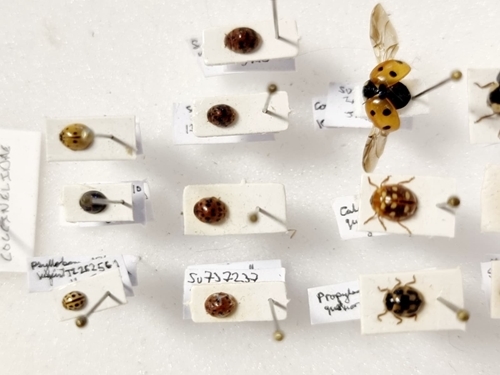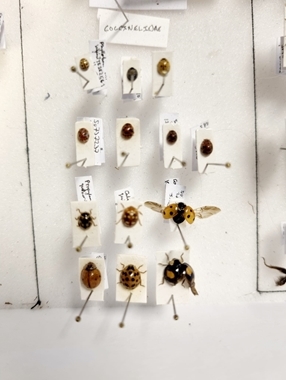Red and black spotted, round and shiny ladybirds are arguably one of the few beetles everyone can recognise. Delve a little deeper however, and the harlequin ladybird has got to be one of the most confusing and contested species found in the UK. Despite being one of the largest ladybirds we see, its multiple different colour forms makes it challenging to identify. I find its white “eyes” the easiest to help distinguish it from species such as our native seven-spot, but other sources will tell you that harlequins brown/orange legs are a key feature.
With so many reports of harlequins swarming the corners of rooms and windows in houses at this time of year, it is easy to forget they were first recorded in England in just 2004. At the time this species raised severe concerns over the safety of our native populations. Ecologists feared they would out compete our native ladybirds for food and habitat. Subsequent studies indicated that bigger species, such as the seven-spot, were not as dramatically affected. In contrast, evaluating the effects on smaller and more easily overlooked ladybird species remains difficult.
Jade Hemsley from the Game and Wildlife Conservation Trust (GWCT) conducted an experiment published in 2021 showing that, while the invasive species is not directly aggressive, their more efficient hunting behaviour meant there is potential for indirect competition between them and the native two-spot ladybird. According to other evidence, native species such as populations of the two-spot have been in decline since at least the 1980s – long before harlequins arrived on the scene.
 When it comes to overwintering habitat there seems to be little evidence of overlap between native species and harlequin ladybirds. For example, our seven-spot ladybirds prefer to huddle in groups under leaf litter, rather than in our houses. Meanwhile, our smaller, less conspicuous native species tend to stay near their summer feeding spots. They are more independent than our larger species, choosing for themselves which bark crevice, moss pile or tree root hide is best for them.
When it comes to overwintering habitat there seems to be little evidence of overlap between native species and harlequin ladybirds. For example, our seven-spot ladybirds prefer to huddle in groups under leaf litter, rather than in our houses. Meanwhile, our smaller, less conspicuous native species tend to stay near their summer feeding spots. They are more independent than our larger species, choosing for themselves which bark crevice, moss pile or tree root hide is best for them.
Ladybirds as biocontrol agents in farmland
Ladybirds are often referred to as gardeners best friends, their main prey being aphids makes for a highly attractive relationship between them and anyone who wants to grow healthy plants. If you’re an arable farmer then the potential for protecting your crops and maybe even reducing pesticide use is even more appetising!
During my time in research it is undoubtable that in aphid hotspots the ladybirds waste no time being right there with them, feasting on the juicy little green and brown bodies clustered along the stems of field beans, peas or other crops. It is important to keep in mind a couple of notes:
- Ladybirds are just one of the fantastic families of insects that provide pest control. Otherwise known as “natural enemies,” other insects, such as parasitic wasps, lacewing larvae, ground beetles, rove beetles, and soldier beetles, all contribute to the web of insects that are farmers’ best friends. It can be difficult to put a direct number on their value or the baseline level of natural enemies needed to control pests, but what we can be sure of is that no one species is the sole solution; we need to support the full matrix of interacting species for the best biocontrol results.
- Ladybirds, like any parasitic or predatory animals, require their prey to be present in a habitat in order to survive. No prey means no predators, so it might be a bit unrealistic to aim for absolute zero when it comes to aphids. We need to support ladybirds and other natural enemies year round through pesticide free habitats and overwintering havens so they can be ready to “keep the peace” and help fight any large surges in pest numbers.
 According to the Royal Horticultural Society the warm weather this year saw booms in aphid numbers. While GWCT research projects are not currently focused on aphids, our team is still busy processing this summer’s field insect samples. However, within the last five years, other papers have also shed light on the interactions between ladybirds and their prey.
According to the Royal Horticultural Society the warm weather this year saw booms in aphid numbers. While GWCT research projects are not currently focused on aphids, our team is still busy processing this summer’s field insect samples. However, within the last five years, other papers have also shed light on the interactions between ladybirds and their prey.
Reading between the…spots… our scientific knowledge on ladybirds
Recent external research has deepened our understanding of how ladybirds and aphids interact, and how we might fine-tune their role as natural pest controllers. For example, a 2025 study by Sariq et al. showed that raising male Propylea dissecta (infamously known as the dissected ladybird) on different aphid species affects their behaviour and mating success. This suggests that the type of aphids available in a field could affect how well they breed and, ultimately, how effective they are at controlling aphid populations.
Another recent study (Thomsen et al. 2024) looked at whether bacteria living inside aphids change how vulnerable they are to ladybird predation. The researchers found that some aphids with these internal bacteria were eaten more quickly under certain temperature conditions, which suggests that the aphids’ microbiomes (their internal bacterial communities) might influence how easily they’re preyed on. Furthermore, Siddiqui et al. 2025, published the knowledge they gained by closely monitoring the seven-spot ladybird throughout their life under lab conditions to gain a deep understanding of their multifaceted ecology, with implications for optimising their biocontrol services.
These findings imply that optimising ladybird biocontrol is not just about increasing predator numbers or habitat, but also understanding which aphid species and strains, and their gut bacteria are present. It is important to note that these studies do not necessarily directly apply to UK farming systems. However in practice, this could mean that fostering a diverse aphid and ladybird community, perhaps by managing plant species in semi-natural habitat could help support more reliable predation. It also reinforces the idea of “right tree, right place” (or right margin, right host plant) extending to selecting vegetation and cropping environments that support aphid–ladybird compatibility, not just habitat for the predator.
This research links to more GWCT findings published in 2021, which enhanced our understanding of aphid ecology and movement, offering valuable context for optimising ladybird biocontrol. Monitoring of cereal yellow dwarf virus aphid vectors by Holland et al. (2021) showed that at least three times more winged cereal aphids are captured near field headlands, particularly adjacent to tall field boundaries. This suggests that boundary features, hedgerows, tree lines, and tall margins, can influence where aphids enter fields, which in turn affects where ladybird predators are needed most. Earlier work also found higher abundances of Rhopalosiphum padi (the bird cherry-oat aphid) next to hedgerows compared to woodland edges, highlighting that boundary type and structure influence aphid immigration into crops.
In combination with the recent findings on ladybird diet and aphid symbionts, this evidence strengthens the case for spatially targeted habitat management. In practice, we might maximise biocontrol by placing or managing habitat refuges and margins along likely aphid entry routes, e.g. planting or structuring margins at edges or hotspots where aphid immigration is greatest, rather than distributing habitat evenly. That way, predatory insects like ladybirds can intercept immigrants earlier and reduce aphid establishment in crops.
Concluding thoughts
I don’t think anyone is suggesting wiping out the cute little black and red clusters of harlequins gathering in our houses any time soon. For winter at least, they are here to stay. With the push towards reducing insecticide use, maybe their more efficient predatory habits are what we need? There are multiple instances across the globe of ladybird species including harlequins, two-spot and 11-spot ladybird species being introduced for their aphid control abilities. However, as with most introduced species, they usually end up spreading far beyond their intended zones and their impact on native ecosystem dynamics is something we, more often than not, want to avoid. Therefore, supporting our native species is for sure the best way forward, through native plants and well-placed pockets of semi-natural habitat - creating networks across our farmland and gardens, we can all do our bit to support balanced ecosystems.